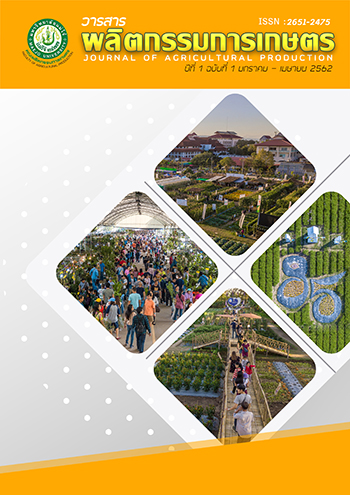ผลของปุ๋ยอินทรีย์ชีวภาพต่อการปลูกทานตะวันที่อำเภอหัวหิน จังหวัดประจวบคีรีขันธ์
Main Article Content
บทคัดย่อ
การศึกษานี้เพื่อประเมินศักยภาพการปลูกทานตะวันในพื้นที่อำเภอหัวหิน จังหวัดประจวบคีรีขันธ์ ทำการประเมินโดยการเปรียบเทียบผลผลิตเมล็ดและเปอร์เซ็นต์นํ้ามันในกรรมวิธีที่แตกต่างกันซึ่งเป็นผล มาจากการใช้ปัจจัยการผลิตที่ต่างกัน ผลการศึกษาพบว่าไม่มีความแตกต่างทางสถิติของผลผลิตจากแปลง ที่ได้รับปัจจัยการผลิตที่แตกต่างกัน ทั้งการไม่ใช้ปุ๋ยและการใช้ปุ๋ยเคมี (สูตร 15-15-15 สำหรับไนโตรเจน ฟอสฟอรัส และโพแทสเซียม อัตรา 30 กิโลกรัมตอ่ ไร) หรือการใชปุ้ย๋ อินทรียช์ ีวภาพในอัตราที่แตกตา่ งกัน(200 และ 400 กิโลกรัมต่อไร่) ผลผลิตเมล็ดและเปอร์เซ็นต์นํ้ามันในเมล็ดทานตะวันที่ปลูกในสองฤดูปลูกทั้งฤดูแล้ง (เดือนกุมภาพันธ์-พฤษภาคม) และปลายฤดูฝน (เดือนกันยายน-ธันวาคม) ในปี พ.ศ. 2558 ได้ผลผลิตเท่ากับ 89.40 และ 103.89 กิโลกรัมต่อไร่ และมีเปอร์เซ็นต์นํ้ามันเท่ากับ 43.61 และ 39.53 เปอร์เซ็นต์ ตามลำดับ จากผลการศึกษานี้ มีข้อแนะนำหลายประเด็นสำหรับเกษตรกรที่สนใจปลูก ทานตะวันในพื้นที่ดังกล่าวนี้ การปรับปรุงดินและการศึกษาเพิ่มเติมเกี่ยวกับการปลูกทานตะวันแบบ ผสมผสานกับพืชชนิดอื่นๆ ในแปลงเกษตรกรเป็นประเด็นที่ต้องคำนึงถึงอย่างมาก รวมทั้งแนวทางอื่น ในการเพิ่มมูลค่าผลผลิตเมล็ดทั้งการแปรรูปเมล็ดเป็นนํ้ามัน รวมทั้งการใช้เศษเหลือจากกระบวนการผลิตนั้นเพื่อใช้เป็นอาหารสัตว์หรือเป็นปุ๋ยอินทรีย์
Article Details

This work is licensed under a Creative Commons Attribution-NonCommercial-NoDerivatives 4.0 International License.
References
AbouKhadrah, S. H., A. A. E. Mohamed, N. R. Gerges and Z.M. Diab. 2002. Response of four sunflower hybrids to low nitrogen fertilizer levels and phosphorinebiofertilizer. J. Agric. Res., Tanta Univ. 28(1): 105-118.
Aowad, M. M. and A. A. A. Mohamed. 2009. The effect of bio, organic and mineralfertilization on productivity of sunflower seed and oil yields. J. Agric. Res. Kafrelsheikh Univ. 35(4): 1013-1028.
Azia, R., M. Shahbaz and M. Ashraf. 2013. Influence of foliar application of triacontanol on growth attributes, gas exchange and chlorophyll fluorescence in sunflower (Helianthus annuus L.) under saline stress. Pak. J. Bot. 45(6): 1913-1918.
Baydar, N. G. and M. Akkurt. 2001. Oil content and oil quality properties of some grape seeds. Turk. J. Agric. For. 25(3): 163-168.
Blackman, B., S. Michaels and L. H. Rieseberg. 2011. Connecting the sun to flowering in sunflower adaptation. Mol. Ecol. 20(17): 3503-3512.
Carrillo-Avila, E., C. Garcia-Acedo, J. Arreola-Enriquez, C. Landeros-Sanchez, M. L. Osnaya-Gonzalez and C. Castillo-Aguilar. 2015. Evaluation of four sunflower hybrids (Helianthus annuus) under three irrigation regimes and two doses of fertilization on flower production. J. Agric. Sci. 7(4): 183-194.
Gliszczyńska-Świglo, A., E. Sikorska, I. Khmelinskii and M. Sikorski. 2007. Tocopherol content in edible plant oils. Pol. J. Food Nutr. Sci. 57(4A): 157-161.
Gonzalez, M. L. and C. Castillo-Aguilar. 2015. Evaluation of four sunflower hybrids (Helianthus annuus) under three irrigation regimes and two does of fertilization on flower production. J. Agric. Sci. 7(4): 183-194.
Goyne, P. J., A. A. Schneiter, K. C. Cleary, R. A. Creelman, W. D. Stegmeier and F. J. Wooding. 1989. Sunflower genotype response to photoperiod and temperature in field environments. Agron. J. 81(5): 826-831.
Grompone, M. A. 2005. Sunflower oil. In: F. Shahidi (ed.) Bailey’s Industrial Oil & Fat Products Volume 2, Edible Oil & Fat Products. Edible oil 6thed.
vanova, P., V. Chalova, L. Koleva, I. Pishtiyski and M. Perifanova-Nemska. 2012. Optimization of protein extraction from sunflower meal produced in Bulgaria. Bulg. J. Agri. Sci. 18(2): 153-160.
Jiang, Z., D. U. Ahn, L. Ladner and J. S. Sim. 1992. Influence of feeding full-fat flax and sunflower seeds on internal and sensory qualities of eggs. Poult. Sci. 71(2): 378-382.
Keneni, G., E. Bekele, M. Imtiaz and K. Dagne. 2012. Genetic vulnerability of modern crop cultivars: causes mechanism and remedies. Int. J. Plant Sci. 2(3): 69-79.
Keshta, M. M., T. Y. Rizk and E. T. Abdou. 2008. Sunflower response to mineral nitrogen, organic and bio-fertilizers under two different levels of salinity. Proceeding 17th International Sunflower Conference, Cordoba, Spain, pp. 451-454.
Khan, A. 2001. Yield performance, heritability and interrelationship in some quantitative traits in sunflower. Helia 24(24): 35-40.
Koné, B., S. Diatta, O. Sylvester, G. Yoro, C. Mameri, D. D. Désiré and A. Ayemou. 2009. Evaluation de la fertilitépotentielle des Ferralsolpar la couleur. Can. J. Soil Sci. 89(3): 331-342.
Leland, E. F. 1996. Salinity effect on four sunflower hybrids. Agron. J. 88(2): 215-219.
Magaia, H. E., M. Freire, A.Monjana, O. DavolioMarani, A. Zazzerni, M.Durante and F. Cecconi. 2005. Selection of new sunflower (Helienthusannuus L.) synthetic varieties adapted for production areas of Mozambique. Helia 28(43): 69-76.
Mauricio, P. and A. Ildeu. 2005. Color attributes and mineralogical characteristics, evaluated by radiometry of highly weathered tropical soils. Soil Sci. Am. J. 69(4): 1162-1172.
Mayo, O. 1989. The theory of plant breeding. Clarendon Press, Oxford. Mohamed, A. A. E. 2003. Response of sunflower to phosphorine and cerealine in inoculation under low NPfertilizer levels J. Agric. Res., Tanta Univ. 29(2):653-663.
Oshundiya, F. O., V. I. O. Olowe, F. A. Sowemino and J. N. Odedina. 2014. Seed yield and quality of sunflower (Helianthus annuus L.) as influenced by staggered sowing and organic fertilizer application in the humid tropics. Helia 37(61): 237-255.
Pavek, J. J. and D. L. Corsini. 2001. Utilization of potato genetic resources in variety development. Amer. J. of Potato Res. 78: 433-441.
Prevc, T., A. Levart, I. K. Cigić, J. Salobir, N. P. Ulrih and B. Cigić. 2015. Rapid estimation of tocopherol content in linseed and sunflower oils-reactivity and assay. Molecules 20(8): 14777-14790.
Rebolé, A., L. Rodgrígues, L. T. Ortiz, C. Alzueta, C. Centeno, A. Viveros, A. Brenes and I. Arija. 2006. Effect of dietary high-oleic sunflower seed, palm oil and vitamin E supplementation on broiler performance, fatty acid composition and oxidation susceptibility of meat. Br. Poult. Sci. 47(5): 581-591.
Rosa, P. M., R. Antoniassi, S. C. Freitas, H. R. Bizzo, D. L. Zanotto, M. F. Oliveira and V. B. R. Castiglioni. 2009. Chemical composition of Brazilian sunflower varieties. Helia 32(50): 145-156.
Russell, W. A. 1953. A study of the interrelationships of seed yield, oil content, and other agronomic characters with sunflower inbred lines and their top crosses. Can. J. Agri. Sci. 33(3): 291-314.
Senkoylu, N. and N. Dale. 1999. Sunflower meal in poultry diets: A review. Worlds Poult. Sci. J. 55(2): 153-174. Shabana, R. 1974. Genetic variability of sunflower varieties and inbred lines, Proceedings of 6th International Sunflower Conferences, Bucharest, Romania, pp. 263-269.
Turhan, H., N. Citak, H. Pehlivanoglu and Z. Mengul. 2010. Effects of ecological and topographic conditions on oil content and fatty acid composition in sunflower. Bulg. J. Agri. Sci. 16(5): 553-558.
Vanitha, J., N. Manivannan and R. Chandirakala. 2014. Qualitative trait loci analysis for seed yield and component traits in sunflower. Afr. J. Biotechnol. 13(6): 754-761.
Wuana, R. A. and F. E. Okieimen. 2011. Heavy metals in contaminated soils: a review of sources, chemistry, risks and best available strategies for remediation. ISRN Ecology. Doi:10.5402/2011/402647.

